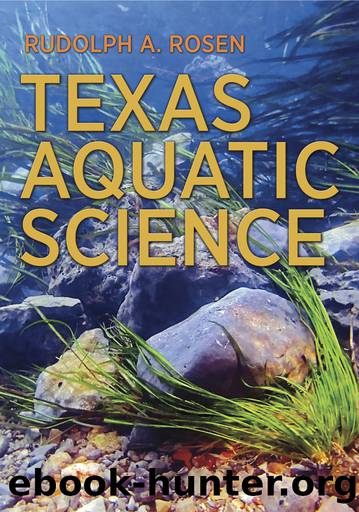Texas Aquatic Science by Rosen Rudolph A.;

Author:Rosen, Rudolph A.; [Rosen, Rudolph A.]
Language: eng
Format: epub
Publisher: Texas A&M University Press
Published: 2014-08-15T00:00:00+00:00
Figure 10.3. Oxbow lakes form when a flood or other natural process cuts off a loop of a river channel, isolating it from the main river. Illustration courtesy of Missouri Department of Conservation.
GULF COAST. Coastal wetlands are formed when saltwater and freshwater mix. Salinities vary widely as freshwater inflow to coastal areas goes up or down. There may be times the water is entirely fresh or times salinity can be greater than in ocean water. These wetlands can form in depressions in the land near the coastâs bays and estuaries. Rains fill these depressions, and sometimes storms push saltwater into them. Coastal wetlands can also form in low-lying areas of land where rivers flow into estuaries and bays. Many coastal wetlands have water levels and salinities that fluctuate daily because they are subjected to tides. These are called tidal wetlands and are the tidal flats, bays, marshes, and bayous we see throughout the Texas coast.
Wetlands Are Special Ecosystems
Wetland plants are adapted to take advantage of every ray of sunlight yet live a life in water. They have ways to expose their leaves to the sun and avoid being shaded by other plants. They also have roots that can pull in water and still get air (fig. 10.4). Plants that grow in shallow water often have roots that tightly hold on to the soil so they can grow tall to reach sunlight. Cattails, rushes, sedges, and arrowheads do this very well. Sedges and rushes have air spaces inside their leaves to transport air and make the leaves buoyant (fig. 10.5). Some plants, such as the water lily, can grow in deeper water while still remaining anchored by roots in the soil because they have a very long, skinny stem (fig. 10.6). There are even plants that float around on the surface. The tiny duckweed has leaves with air spaces and grows in open water to avoid the shade of taller plants. Its roots are short and hang down in the nutrient-rich water. Coastal wetland plants, such as mangrove and salicornia, can live in water having a high salinity. These plants are called halophytes.
Animals that live in wetlands are special, too. Wetlands are home to many invertebrates, amphibians, reptiles, fish, birds, and mammals. Predators here are adapted to find and catch prey in wet places. The whirligig beetleâs eyes focus both above and below water level to help it find prey. The black-necked stiltâs long legs and specially adapted feet allow it to walk on mud (fig. 10.7). Stilts can snatch fish and tadpoles from underwater with their long, slender beaks. The frogâs long springlike legs and the turtleâs shell help them escape predators. Ducks have spoonlike, flattened bills that make it easy for them to strain seeds and invertebrates from shallow water.
Download
This site does not store any files on its server. We only index and link to content provided by other sites. Please contact the content providers to delete copyright contents if any and email us, we'll remove relevant links or contents immediately.
The Lonely City by Olivia Laing(4584)
Animal Frequency by Melissa Alvarez(4182)
All Creatures Great and Small by James Herriot(4009)
Walking by Henry David Thoreau(3705)
Exit West by Mohsin Hamid(3654)
Origin Story: A Big History of Everything by David Christian(3492)
COSMOS by Carl Sagan(3374)
How to Read Water: Clues and Patterns from Puddles to the Sea (Natural Navigation) by Tristan Gooley(3261)
Hedgerow by John Wright(3129)
How to Do Nothing by Jenny Odell(3116)
The Inner Life of Animals by Peter Wohlleben(3114)
How to Read Nature by Tristan Gooley(3098)
Project Animal Farm: An Accidental Journey into the Secret World of Farming and the Truth About Our Food by Sonia Faruqi(3037)
Origin Story by David Christian(3013)
Water by Ian Miller(2980)
A Forest Journey by John Perlin(2932)
The Plant Messiah by Carlos Magdalena(2765)
A Wilder Time by William E. Glassley(2705)
Forests: A Very Short Introduction by Jaboury Ghazoul(2685)
